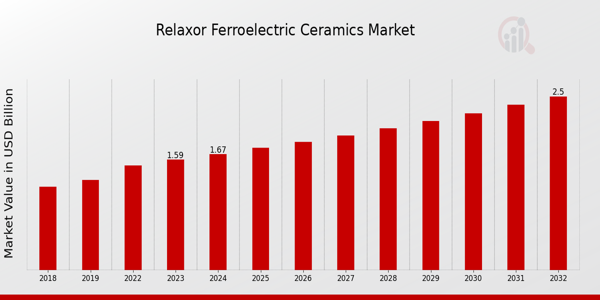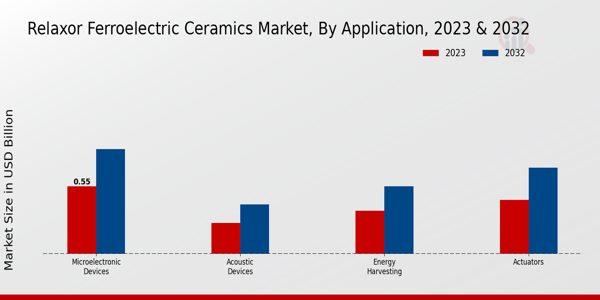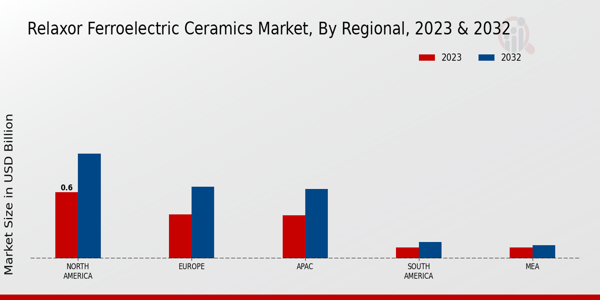Global Relaxor Ferroelectric Ceramics Market Overview
The Relaxor Ferroelectric Ceramics Market Size was estimated at 1.76 (USD Billion) in 2024. The Relaxor Ferroelectric Ceramics Market is expected to grow from 1.85 (USD Billion) in 2025 to 2.90 (USD Billion) by 2034. The Relaxor Ferroelectric Ceramics Market CAGR (growth rate) is expected to be around 5.2% during the forecast period (2025 - 2034).
Key Relaxor Ferroelectric Ceramics Market Trends Highlighted
The global market for relaxor ferroelectric ceramics is expanding significantly due to a number of important factors. One of the main factors driving the market is the rising demand for electronic gadgets and sophisticated communication systems. These ceramics are prized for their special dielectric qualities, which make them indispensable in transducers, sensors, and capacitors.
Additionally, producers are being pushed to look for materials that may maintain performance while reducing size due to the drive toward electronics shrinking. The demand for these ceramics in energy storage systems and sophisticated sensors is also being increased by the growth of the automobile industry, especially in electric and hybrid vehicles.
Opportunities in this market can be captured by investing in research and development to enhance the properties of relaxor ferroelectric ceramics. Innovations focused on improving temperature stability and reducing production costs can open doors to new applications, especially in industries like aerospace, healthcare, and renewable energy.
Furthermore, expanding production capacities to meet the growing market demand can lead to strategic advantages. As global industries continue to innovate and adopt advanced materials, the market for relaxor ferroelectric ceramics is likely to expand.
In recent times, there has been a noticeable trend towards sustainable manufacturing practices in the ceramics industry.
Companies are increasingly adopting environmentally friendly processes and materials to minimize their ecological footprint.
Furthermore, the focus on smart technologies and Internet of Things (IoT) applications is driving the development of advanced ceramic materials that can contribute to more efficient and intelligent systems.
This shift reflects a broader trend across various sectors, emphasizing the importance of sustainability and technology integration. Overall, the Relaxor Ferroelectric Ceramics Market is poised for continued evolution, shaped by these dynamic trends and opportunities.

Source: Primary Research, Secondary Research, MRFR Database and Analyst Review
Relaxor Ferroelectric Ceramics Market Drivers
Technological Advancements in Material Science
The Relaxor Ferroelectric Ceramics Market is witnessing significant technological advancements in material science, which is driving the development and application of relaxor ferroelectric ceramics across various sectors.
These innovations are aimed at enhancing the performance characteristics of the ceramics, making them more efficient, durable, and suitable for a wide range of applications.
Factors such as improved processing techniques, a better understanding of the material properties, and novel synthesis methods are resulting in higher quality and more versatile relaxor ferroelectric ceramics.
In addition, advancements in characterization methods enable researchers to investigate the intricate properties of these materials in great detail, leading to the identification of new applications.
Furthermore, the integration of advanced technologies like 3D printing and other additive manufacturing processes is revolutionizing the production of relaxor ferroelectric ceramics, allowing for greater customization and reduction in waste.
This not only enhances the market dynamics but also opens doors for innovative applications in fields such as electronics, telecommunications, and automotive industries.
As the demand for high-performance materials increases, the technological innovations in the Relaxor Ferroelectric Ceramics Market will serve as a robust driver for market growth and future prospects.
Growing Demand from Electronics Industry
The electronics industry is one of the primary drivers of growth in the Relaxor Ferroelectric Ceramics Market. The need for advanced materials that can improve the efficiency and performance of electronic devices is on the rise.
Relaxor ferroelectric ceramics are well known for their unique properties, such as high dielectric constant and low loss tangent, making them ideal for applications in capacitors, sensors, and actuators.
As smart technologies and electronic devices become more prevalent, the search for materials that can enable miniaturization and enhance device functionality drives the demand for relaxor ferroelectric ceramics.
Consequently, manufacturers are focusing on research and development to create specialized ceramics that cater to the specific requirements of the electronics industry.
Increasing Applications in Telecommunications
The telecommunications sector is witnessing an increased utilization of relaxor ferroelectric ceramics due to their superior dielectric properties.
As bandwidth demand rises and the need for more efficient communication technologies grows, the Relaxor Ferroelectric Ceramics Market is set to benefit significantly. These ceramics are being used in the design of filters, resonators, and components that are essential for modern communication systems.
The ability to improve signal integrity and reduce interference has made relaxor ferroelectric ceramics a crucial component in next-generation communication devices, thus driving the market forward.
Relaxor Ferroelectric Ceramics Market Segment Insights
Relaxor Ferroelectric Ceramics Market Application Insights
The Relaxor Ferroelectric Ceramics Market is expected to witness substantial growth, particularly within various applications that leverage its unique properties.
The application of Relaxor Ferroelectric Ceramics was segmented into key areas such as Microelectronic Devices, Acoustic Devices, Energy Harvesting, and Actuators, each contributing significantly to the overall market growth.
In 2023, the Microelectronic Devices application was valued at 0.55 USD Billion, and by 2032, this value is projected to increase to 0.85 USD Billion. This segment held a majority position, driven by the demand for advanced electronic components that require specific material characteristics, such as high dielectric constant and tunability, essential for modern electronic devices.
Acoustic Devices were anticipated to reach a valuation of 0.25 USD Billion in 2023, expected to grow to 0.4 USD Billion by 2032. This segment was significant because of the growing use of Relaxor Ferroelectric Ceramics in sensors and transducers, where high sensitivity and precision are critical.
Similarly, the Energy Harvesting application stood at 0.35 USD Billion in 2023, with projections showing a rise to 0.55 USD Billion by 2032.
This segment was increasingly important, as it focused on sustainable energy solutions and the ability to convert environmental energy into usable electrical energy, thus playing a vital role in the broader context of energy efficiency and sustainability practices.
Lastly, the Actuators segment was valued at 0.44 USD Billion in 2023, with expectations of growth to 0.7 USD Billion by 2032. It remained significant due to its applications in precision movement technologies that require reliable and responsive actuation capabilities.
Overall, the diverse spectrum of applications within the Relaxor Ferroelectric Ceramics Market reflected an array of growth drivers, challenges, and opportunities that contribute to its evolving landscape.
The increasing focus on technological advancements and the expanding need for high-performance materials in various sectors underlined the critical role of Relaxor Ferroelectric Ceramics across these applications, thus forming a substantial part of the Relaxor Ferroelectric Ceramics Market statistics and data.

Source: Primary Research, Secondary Research, MRFR Database and Analyst Review
Relaxor Ferroelectric Ceramics Market Material Type Insights
The segment encompasses various categories, prominently including Lead-Based Ceramics, which have historically played a vital role due to their excellent piezoelectric properties. Meanwhile, the significance of Lead-Free Ceramics is on the rise as regulations tighten around lead usage, making these materials vital for sustainable applications.
Composite Ceramics also contribute to the market by combining the benefits of different materials, leading to improved performance in electronic devices, which caters to the technological advancements in the electronics industry.
The increasing demand for advanced materials in applications such as sensors, actuators, and energy storage devices drives growth in this segment. However, challenges such as sourcing raw materials and meeting regulatory requirements persist.
As the market dynamics evolve, opportunities will likely emerge for innovation and adoption of new materials, reflecting the continual demand for the Relaxor Ferroelectric Ceramics Market.
Relaxor Ferroelectric Ceramics Market End Use Industry Insights
The Consumer Electronics sector is a major contributor, driven by the demand for advanced electronic devices and components that utilize relaxor ferroelectric ceramics for enhanced performance. Similarly, the Aerospace industry leverages these materials for their lightweight and effective piezoelectric properties, which are essential in various applications.
The Automotive sector plays a crucial role as well, focusing on electric and hybrid vehicles where such ceramics optimize performance and energy efficiency.
Meanwhile, the Healthcare industry seeks reliability and high sensitivity in medical devices, making relaxor ferroelectric ceramics vital for diagnostic and therapeutic equipment.
These segments collectively shape the market landscape, reflecting the unity of technological advancement and industrial demand, contributing to the overall market growth and presenting diverse opportunities for stakeholders within the Relaxor Ferroelectric Ceramics Market.
Emerging trends suggest an increasing focus on biocompatible materials in healthcare applications, showcasing a robust avenue for innovation and expansion within this market.
Relaxor Ferroelectric Ceramics Market Form Insights
The Relaxor Ferroelectric Ceramics Market showcases diverse applications across various forms including Disks, Plates, Pills, and Powders. This market segmentation plays a critical role, with each form serving unique industrial needs, particularly in electronics, telecommunications, and energy storage systems.
In this market, Disks and Plates dominate due to their favorable properties, which enhance efficiency in devices requiring precise electrical characteristics.
Powders are gaining traction as they facilitate the production of high-performance ceramics for specialized applications, while Pills are recognized for their convenient form factor in integrated circuits.
The continuous advancements in material science and technology act as significant growth drivers, fostering innovation in the Relaxor Ferroelectric Ceramics Market.
However, challenges related to manufacturing costs and material constraints persist, creating opportunities for companies to develop more cost-effective solutions. Overall, the Relaxor Ferroelectric Ceramics Market data indicates a promising trajectory as industries adapt and evolve with emerging trends and supportive legislation.
Relaxor Ferroelectric Ceramics Market Regional Insights
Notably, North America emerged as the dominant player, holding a significant market share with a valuation of 0.6 USD Billion in 2023, which is expected to rise to 0.95 USD Billion by 2032. Europe followed, with a market value of 0.4 USD Billion in 2023, indicating its substantial involvement in the Relaxor Ferroelectric Ceramics Market.
APAC contributed with a valuation of 0.39 USD Billion, reflecting its growing demand, while South America and MEA both remained relatively smaller markets, valued at 0.1 USD Billion each in 2023.
However, South America's potential was highlighted by a projected increase to 0.15 USD Billion by 2032, while MEA is seen to grow to 0.12 USD Billion, indicating gradual market development.
The varying growth rates among these regions underscore the different industrial demands and technological advancements driving applications of Relaxor Ferroelectric Ceramics.
The regional segmentation of the Relaxor Ferroelectric Ceramics Market data reveals key insights into market dynamics and opportunities for future investments.

Source: Primary Research, Secondary Research, MRFR Database and Analyst Review
Relaxor Ferroelectric Ceramics Market Key Players and Competitive Insights
The Relaxor Ferroelectric Ceramics Market is characterized by rapidly evolving technological advancements and intense competition among key players striving for market leadership. As the demand for high-performance materials increases across various industries, manufacturers are investing in research and development to enhance the properties and applications of relaxor ferroelectric ceramics.
The market is influenced by a plethora of factors, including consumer preferences, regulatory frameworks, and innovative manufacturing processes. Companies are increasingly focusing on creating differentiated products that cater to specific applications such as actuators, sensors, and energy storage devices.
Collaboration with research institutions and strategic partnerships are common strategies employed by industry participants to drive innovation and expand their market footprint.
Furthermore, sustainability trends are shaping manufacturing approaches, leading to the introduction of eco-friendly practices in the production of relaxor ferroelectric ceramics.
Morgan Advanced Materials has established a significant presence in the Relaxor Ferroelectric Ceramics Market through its strong commitment to innovation and product development. The company leverages its extensive technical expertise to produce high-quality ceramics that exhibit superior performance characteristics.
Morgan Advanced Materials is known for its robust manufacturing capabilities, which allow for the customization of materials to meet specific client requirements.
Its focus on sustainability is a critical strength, enabling the company to enhance its market appeal while adhering to eco-friendly practices in production. The company's strategic investments in research and technological advancements have positioned it as a key player in developing advanced relaxor ferroelectric ceramics, thus fulfilling the increasing market demand for reliable and efficient materials.
Piezotech has emerged as a notable competitor within the Relaxor Ferroelectric Ceramics Market by focusing on the niche segment of high-performance piezoelectric materials. The company has achieved recognition for its innovative solutions that cater to various applications, such as ultrasonic devices and transducers.
Piezotech's strength lies in its commitment to quality and reliability, which is reflected in its rigorous testing and quality control processes. Their advanced research initiatives have led to breakthroughs in relaxor ferroelectric ceramics that offer exceptional electromechanical properties, allowing for greater energy conversion efficiency.
Piezotech's adaptability to market trends and responsiveness to client needs further solidify its position in the competitive landscape, making it a preferred partner for businesses seeking specialized materials for their projects.
By continuously enhancing their research capabilities and expanding their product offerings, Piezotech is well-positioned to capitalize on emerging opportunities within the market.
Key Companies in the Relaxor Ferroelectric Ceramics Market Include
- Morgan Advanced Materials
- Piezotech
- Texas Instruments
- Kyocera
- AVX Corporation
- Harbin Institute of Technology
- Honeywell
- Noliac
- STMicroelectronics
- University of California
- Samsung ElectroMechanics
- CeramTec
- Toshiba
- Meggitt
Relaxor Ferroelectric Ceramics Market Developments
Recent developments in the Relaxor Ferroelectric Ceramics Market have been notable, particularly concerning advancements in technology and product applications. Companies like Morgan Advanced Materials and Kyocera are focusing on enhancing their manufacturing processes and exploring new uses in electronics and telecommunications.
Piezotech and Honeywell continue to innovate in the field of power electronics, leading to the broader adoption of relaxor ferroelectric materials. Furthermore, significant growth has been noted in the market valuation of companies such as Texas Instruments and Samsung ElectroMechanics, which is driving increased investments in research and development.
In terms of mergers and acquisitions, CeramTec and Meggitt are among the companies that have shown strategic interest, looking to consolidate their positions and expand their product offerings.
The University of California has also been involved in collaborative efforts with various companies to further advance research in relaxor ferroelectric ceramics.
This collective momentum in both technological advancements and strategic corporate actions is leading the market toward robust growth, providing enhanced functionalities across various sectors, including consumer electronics and automotive applications.
Relaxor Ferroelectric Ceramics Market Segmentation Insights
- Relaxor Ferroelectric Ceramics Market Application Outlook
- Microelectronic Devices
- Acoustic Devices
- Energy Harvesting
- Actuators
- Relaxor Ferroelectric Ceramics Market Material Type Outlook
- Lead-Based Ceramics
- Lead-Free Ceramics
- Composite Ceramics
- Relaxor Ferroelectric Ceramics Market End Use Industry Outlook
- Consumer Electronics
- Aerospace
- Automotive
- Healthcare
- Relaxor Ferroelectric Ceramics Market Form Outlook
- Disks
- Plates
- Pills
- Powders
| Report Attribute/Metric |
Details |
| Market Size 2024 |
1.76 (USD Billion) |
| Market Size 2025 |
1.85 (USD Billion) |
| Market Size 2034 |
2.90 (USD Billion) |
| Compound Annual Growth Rate (CAGR) |
5.2% (2025 - 2034) |
| Report Coverage |
Revenue Forecast, Competitive Landscape, Growth Factors, and Trends |
| Base Year |
2024 |
| Market Forecast Period |
2025 - 2034 |
| Historical Data |
2020 - 2024 |
| Market Forecast Units |
USD Billion |
| Key Companies Profiled |
Morgan Advanced Materials, Piezotech, Texas Instruments, Kyocera, AVX Corporation, Harbin Institute of Technology, Honeywell, Noliac, STMicroelectronics, University of California, Samsung ElectroMechanics, CeramTec, Toshiba, Meggitt |
| Segments Covered |
Application, Material Type, End Use Industry, Form, Regional |
| Key Market Opportunities |
Increased demand in electronics, Advancements in energy harvesting, Growth in medical device applications, Expanding aerospace sector usage, and Rising use in telecommunications. |
| Key Market Dynamics |
Growing demand in electronics, Advancements in material properties, Increasing applications in energy, Rising investments in research, Expanding automotive sector usage |
| Countries Covered |
North America, Europe, APAC, South America, MEA |
Frequently Asked Questions (FAQ) :
The Relaxor Ferroelectric Ceramics Market is expected to be valued at 2.90 USD Billion in 2034.
The market is anticipated to grow at a CAGR of 5.2% from 2025 to 2034.
North America is expected to hold the largest market value at 0.95 USD Billion in 2034.
The market size for Microelectronic Devices is projected to reach 0.85 USD Billion by 2034.
Key players include Morgan Advanced Materials, Texas Instruments, Kyocera, and Honeywell.
The expected market value for Acoustic Devices is projected to be 0.4 USD Billion in 2034.
The market for Energy Harvesting applications is anticipated to reach 0.55 USD Billion in 2034.
The market in the APAC region is expected to grow to 0.63 USD Billion by 2034.
The market value for Actuators is projected to be 0.7 USD Billion in 2034.
The expected market value for South America is anticipated to be 0.15 USD Billion in 2034.

















